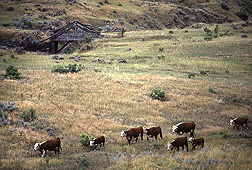Green Acres
Lush, seeded pastures sprout with all
sorts of possibilities for Great Plains ranchers
|
|
At ARS’s livestock and rangeland research facility in Miles City, Montana, forage expert Marshall Haferkamp is sending a herd of cattle out to pasture—and watching them prosper.
A rangeland scientist at the Fort Keogh Livestock and Range Research Laboratory, Haferkamp has found that seeded pastures, planted with well-adapted perennial grasses, can help round out a herd’s yearly nutritional needs. After all, high-quality forage that’s needed by growing livestock is sometimes hard to come by in this region’s coarse landscape dominated by tufts of native grasses and sagebrush.
Haferkamp knows that in the semiarid plains of southeastern Montana, a rainy spring or extended summer drought can make or break a rancher’s hopes for a good profit from his cattle. “Whatever rain we get in April, May, and June,” he says, “will determine how much forage is available that year for cattle to graze on.”
So by planting pastures with vigorous perennial grasses acclimated to the area, ranchers might be able to exert a little more control when it comes to meeting their herds’ nutritional needs. These managed pastures can also be used to defer use of native rangelands—allowing fragile or recuperating sites to recover.
“The notion of seeded pastures isn’t new,” explains Haferkamp. “But we wanted to see how some of the released varieties of cool-season grasses would work in the Northern Great Plains in spring and autumn, when the quality of native rangelands isn’t as high. This was also the first time we compared the nutritional potential of seeded pastures with that of native rangelands, over the course of several months.”
For help on selecting grasses well suited to the demanding, badlands-type environment found in eastern Montana, Haferkamp collaborated with plant breeders at ARS’s Forage and Range Research Laboratory in Logan, Utah. There, a few different spring and autumn cool-season cultivars were chosen for the trials. These grasses were given about 2 years to establish themselves before cattle were moved in to graze.
In the end, the specially seeded pastures provided animals with better nutritional opportunities—allowing the cattle feeding on those pastures to put on more pounds in the spring and fall.
“We found that the spring pastures could provide higher levels of protein and greater digestibility for the animals,” says Elaine Grings, an ARS animal nutritionist who worked with Haferkamp on the study.
“What was surprising,” says Michael MacNeil, an ARS geneticist who also contributed to the research, “was that animals grazing the seeded pastures in spring and then moved to native rangeland in summer weren’t able to maintain their initial weight gain.” Over the summer when all animals grazed native rangeland, those that grew more slowly during spring caught up with the faster growing ones. Ranchers can use this information to market their livestock more strategically.
The autumn-type seeded pastures could play a pivotal role too. “Winter is a stressful time for animals,” explains Grings. “Our study shows how certain autumn grasses can be used to put weight on pregnant animals going into winter, just when they need it most.”—By Erin K. Peabody, Agricultural Research Service Information Staff.
This research is part of Rangeland, Pasture, and Forages (#205) and Food Animal Production (#101), two ARS National Programs described on the World Wide Web at www.nps.ars.usda.gov.
Marshall R. Haferkamp, Elaine E. Grings, and Michael D. MacNeil are with the USDA-ARS Fort Keogh Livestock and Range Research Laboratory, 243 Fort Keogh Rd., Miles City, MT 59301-4016; phone (406) 874-8211, fax (406) 874-8289.
"Green Acres" was published in the February 2006 issue of Agricultural Research magazine.







